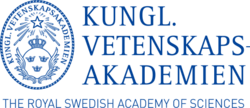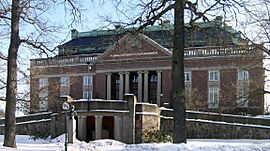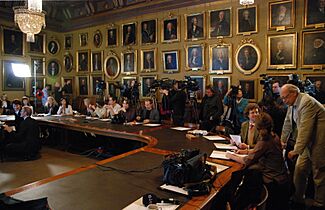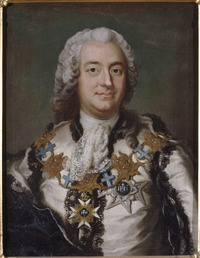Royal Swedish Academy of Sciences facts for kids
|
Kungliga Vetenskapsakademien
|
|
 |
|

The main building of the Royal Swedish Academy of Sciences in Stockholm, Sweden.
|
|
| Formation | 2 June 1739 |
|---|---|
| Headquarters | Stockholm, Sweden |
|
Membership
|
470 Members (including 175 Foreign members) |
|
President
|
Birgitta Henriques Normark |
|
Secretary General
|
Hans Ellegren |
The Royal Swedish Academy of Sciences is one of Sweden's most important science organizations. In Swedish, it's called Kungliga Vetenskapsakademien. It's like a special club for the country's top experts in natural science and mathematics.
Founded on June 2, 1739, the Academy is an independent group. This means it doesn't work for the government. Its main job is to support science and make sure it has a strong voice in society. The Academy brings scientists from different fields together to share ideas.
Every year, the Academy gets to do a very famous job: it chooses the winners of the Nobel Prizes in Physics and Chemistry. It also awards the prize for Economic Sciences.
Contents
What the Academy Does
The Academy has several important goals:
- To be a place where scientists from different fields can meet and share ideas.
- To support young researchers at the start of their careers.
- To give awards to celebrate amazing work in science.
- To help scientists from around the world work together.
- To speak up for science in society and help guide decisions about research.
- To get students excited about math and science in school.
- To share scientific knowledge with the public in easy-to-understand ways.
Famous Prizes
The Academy is famous for awarding some of the world's most important prizes in science.
Prizes for the World
- Nobel Prizes: The Academy chooses the winners for Physics and Chemistry.
- Sveriges Riksbank Prize in Economic Sciences in Memory of Alfred Nobel: This is often called the Nobel Prize in Economics.
- Crafoord Prizes: These are awarded in fields that the Nobel Prizes don't cover, like astronomy, mathematics, geosciences (the study of Earth), and biosciences (the study of living things).
- Sjöberg Prize: This prize is for major breakthroughs in cancer research.
- Rolf Schock Prizes: Given for amazing work in logic, philosophy, mathematics, and the arts.
- Gregori Aminoff Prize: Awarded for important discoveries in crystallography (the study of crystals).
Prizes for Sweden
The Academy also gives out national prizes to support science within Sweden.
- Göran Gustafsson Prize: For top researchers in chemistry, math, medicine, physics, and molecular biology.
- Söderberg Prize: For research in economics, law, or medicine.
- Ingvar Lindqvist Prizes: These awards go to outstanding teachers in science and math.
- Tage Erlander Prize: Given to young researchers in four different areas of science and technology.
Who Are the Members?
Since it was founded in 1739, the Academy has chosen about 1,700 Swedish members and 1,200 members from other countries. Today, there are around 470 Swedish members and 175 foreign members.
The members are experts in their fields and are divided into ten groups, called "classes":
- Mathematics
- Astronomy and Space Science
- Physics
- Chemistry
- Geosciences (study of the Earth)
- Biosciences (study of life)
- Medical Sciences
- Engineering sciences
- Social sciences (study of human society)
- Humanities (study of human culture) and for special service to science
History of the Academy
The Academy was started on June 2, 1739, by a group of six talented people. They included the famous naturalist Carl Linnaeus, the engineer Mårten Triewald, and the politician Anders Johan von Höpken.
Their goal was to create an academy focused on practical knowledge that could help society. They also wanted to publish their findings in the Swedish, not Latin. At the time, most scientific papers were in Latin, which only a few educated people could read. By using Swedish, the founders hoped to share knowledge with many more people.
The founders modeled their new academy on successful scientific groups in other countries, like the Royal Society of London in England and the Academy of Sciences in Paris, France.
See also
 In Spanish: Real Academia de las Ciencias de Suecia para niños
In Spanish: Real Academia de las Ciencias de Suecia para niños
- Members of the Royal Swedish Academy of Sciences



